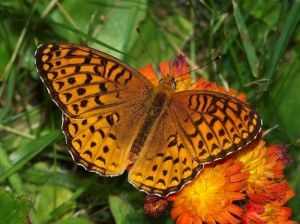New Evidence for Climate Change: Butterflies
The meticulous records of an amateur butterfly club in New England are opening a window into changes happening to the regional climate
/https://tf-cmsv2-smithsonianmag-media.s3.amazonaws.com/filer/20120821095044butterfly_giant_swallowtail_model-small.jpg)
Over the past few decades, researchers have found evidence that the global climate is changing in an increasingly wide range of places: the retreat of Arctic sea ice, the gradual acidification of the oceans and the overall warming of the atmosphere. A new study by researchers draws upon a more unlikely source—19 years of records of an amateur naturalist group called the Massachusetts Butterfly Club.
It all started when Harvard biologist Greg Breed and his colleagues, who conduct research in the 3000-acre tract of land known as the Harvard Forest, wanted to look into the movements of migratory animal populations over time as a proxy for regional climate shifts. If warmer-climate species were slowly moving into the area, it could indicate a steady warming of the climate over time. They found, however, that no researchers had collected thorough data on any migratory animal species in the region.
Then they discovered that the amateur members of the Butterfly Club had kept meticulous records of the species they saw for nearly two decades, carefully charting each butterfly they encountered on nearly 20,000 butterfly-observing expeditions across the state. Breed and the others realized they could analyze this rich data set in order to develop an understanding of climatic changes over time.
Their results, published on Sunday in the journal Nature Climate Change, are heartening in that they put to good use the careful work of citizen scientists—and depressing in that they provide further support for the fact that the climate is changing and disrupting wildlife populations. “Over the past 19 years, a warming climate has been reshaping Massachusetts butterfly communities,” Breed said in a Harvard press release.
Specifically, the research team found that a number of temperate or even subtropical butterfly species that historically had ranges that ended south of Massachusetts have been showing up in ever-greater numbers in recent years. The zebulon skipper, for instance, was virtually unknown in Massachusetts in the 1980s. Over the past two decades, though, the butterfly club members spotted them more and more often—and they were 18 times more likely to spot a zebulon skipper in 2011 than in 1992, the first year of the records.
Conversely, species that originally had ranges that started roughly in Massachusetts and extended mostly to the North were much less likely to be found as of 2011. More than 75 percent of the species that had a range with a center north of Boston had decreasing populations over the course of the study. Presumably, these species moved north to stay within the range of their preferred climate. On the other hand, southerly species were disproportionately more likely to increase in population in Massachusetts over time, as they followed their preferred climate into the state.

The researchers say this raises issues with current methods of butterfly species protection—and, for that matter, protection for all forms of wildlife that easily migrate between different locales. Many of the species that had experienced a rapid increase in population were still under formal protection, such as the frosted elfin, which had become 10 times more frequent over the course of the study. On the other hand, many northerly species had declined dramatically but still haven’t been listed as threatened and don’t receive formal protection measures. The researchers advocate more responsive updating of threatened and endangered species lists based on the latest data.
Of course, a more accurate rendering of which species are at risk won’t help much if our approach to conserving them is outdated, too. Traditionally, butterfly conservation methods focus on habitat protection as a key strategy, but this type of work demonstrates that in our new, quickly changing climate, local habitat might be less important than shifting boundaries between previously stable climate zones. “For most butterfly species, climate change seems to be a stronger change-agent than habitat loss,” Breed said. “Protecting habitat remains a key management strategy, and that may help some butterfly species. However, for many others, habitat protection will not mitigate the impacts of warming.”
/https://tf-cmsv2-smithsonianmag-media.s3.amazonaws.com/accounts/headshot/joseph-stromberg-240.jpg)
/https://tf-cmsv2-smithsonianmag-media.s3.amazonaws.com/accounts/headshot/joseph-stromberg-240.jpg)